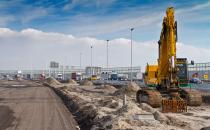SELC op-ed: Cap-in-place is pollute-in-place when it comes to coal ash
Senior Attorney Frank Holleman recently wrote a response in Utility Dive to industry executives claiming that cap-in-place is a fine solution for tons of coal ash, a toxin-laden waste stored at coal-fired power plants across the country. Unregulated for years, mountains of coal ash have built up along rivers and lakes and many utilities would like to simply cover the piles up and move on. But we know the piles are leaching pollution out from the bottom, as groundwater, well and downstream testing has shown. In his piece, Holleman reminds readers that what seems like the cheap way out can quickly become costly as evidence of pollution mounts.
An excerpt of Holleman’s piece is below. You can read the full article here.
Southeastern utilities have come to regret following the shop worn advice rehashed in a recent Utility Dive opinion piece: Don't worry about cleaning up your leaking unlined waterfront coal ash lagoons — you'll be just fine if you cap them in place (“Ash ponds: Keep calm and close in place,” Jan. 15, 2020).
Instead, forward-thinking utilities recognize that their communities and increasingly-stringent standards require more than leaving coal ash in polluting pits and have moved their coal ash to dry lined storage — a requirement even for the storage of the household garbage cited in the Jan. 15 piece.
Storing any waste, much less coal ash, in a dry, lined landfill away from water is the most basic form of modern waste disposal options.
Take, for example, Duke Energy.
After community groups identified Clean Water Act violations at Duke Energy sites in North Carolina, Duke Energy at first insisted that cap in place was fine, that unlined storage was safe and complied with all laws. The utility fought in and out of court and alienated its neighboring communities.
During acrimonious litigation, virtually every newspaper in the state editorialized against the company's position.
The fight brought scrutiny to coal ash storage across North Carolina, the state identified violations at all sites, lawsuits erupted, and a criminal grand jury was empaneled. Duke Energy was caught off guard when its Dan River site collapsed, spilling coal ash and polluted water into two states.
After years of extensive studies, North Carolina's environmental agency concluded that polluting coal ash was sitting deep in groundwater at these sites and that excavation — not cap in place — was the required solution.
In the course of this fight, Duke Energy suffered multiple guilty pleas, fines of over $100 million and five years criminal probation. It got caught up in litigation at all its 14 coal ash sites. It severely hurt its reputation. It expended untold management hours and large sums of money on lawsuits.
Now, after over eight years of litigation, Duke Energy agreed to excavate coal ash from unlined impoundments and landfills at all its North Carolina sites and move the ash to dry lined storage or recycle it into cement and concrete. The utility is beginning to rebuild its relationship with its neighbors.
Duke Energy is only the most recent utility to agree that cleaning up its coal ash is the right solution. In Virginia, after years of litigation and fighting with community groups, Dominion accepted legislation to excavate all its unlined lagoons to lined landfill storage or recycling — the bill passed nearly unanimously last year at a time when the state's government was divided between the parties.
In South Carolina, all three utilities — Duke Energy, SCE&G (now owned by Dominion) and Santee Cooper — are cleaning up every one of their unlined riverfront lagoons.
There hasn't been any coal ash utility controversy in the state for almost five years, and these utilities saved a fortune in legal and consultant fees. The first South Carolina sites to be cleaned up are now fully excavated. Arsenic groundwater contamination dropped by more than 90%.
Today, Southeastern utilities are excavating 250 million tons of coal ash at what we estimate to be about 70% of the impoundments covered by the CCR Rule — and other sites are in dispute.
A number of utilities have stopped wasting money on legal and consultant fees and on damaging fights. They do not want to risk wasting huge sums on cap in place, only to be forced to excavate in the future when pollution persists and community requirements continue to tighten. Excavation is now the established industry standard.


